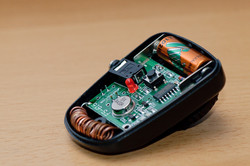If you are among the photographers that use lighting and like to share their techniques, you will probably describe your lighting setups for a particular photograph. But writting a description of a lighting setups is better if illustrated by a lighting diagram: one diagram is worth thousand words! Actually a lighting diagram can even save you typing a long description.
But drawing (by hand or with softwares like Illustrator) is maybe not your cup of tea. So one solution is to use ready-to-use lighting diagrams methods
One of the method is to use a template file containing a set of icons representing photographics objects (camera, umbrella, strobes...) and build your diagram from there. It is usually a PSD file with each object in a single layer. You then just need to hide/unhide a layer, duplicate it, rotate/move it to create your diagram.
A second method, which is more practical and does not require any software installation, is to use an online lighting diagram creator/editor.
I've been living in London since June 2006. By September/October 2006, if memory serves, I've joined the Ealing & Hampshire House Photography Society (EHHPS) after Googling for some camera club in my area. The club exists for quite some years now and meets every Thursday evening at 8pm at the Ealing Town Hall. There are two competitions per month, one print and one digital and we usually socialise in a pub nearby after each meeting.
After a little while I've joined few other clubs and groups such as the LPMG and the London Strobist group.
Joining a camera club is very useful and fun. It allows you to show your work and see the ones from other photographers. This is great as you can discuss ones technique and learn from that. Competitions from photographic societies are interesting, having good or bad marks does not always mean that your picture is a wow or a crap, but it helps with understanding and improving your skills in some areas.
Gadget Infinity is an online shop based in Hong Kong specialized in electronic gadgets that truly reflects the sophisticated design of every tiny invention. They provide a wide range of electronic goods for digital cameras such as batteries, charger, flashguns, GPS adapter, wireless shutter, wireless flash triggers etc...
One of their most popular product is the Cactus V2 and V2s, a cheap flash radio trigger that allows you to wirelessly remote trigger your speedlight. When the pro top level radio triggers (Pocket Wizard) cost around £300 the set of transmitter and receiver, the GI Cactus triggers cost around £22.
The down side of these cheap triggers is their reliability and range. Their range is variable, some photographers did witness a range of 45 meters, on the field I've noticed a max range of 4 meters on my ones. Depending whether you shoot indoors or outdoors and if you are close from any radio interference they can be more or less reliable, but often you will notice lots of misfires.
But then more and more photographers that happen to also be DIYers posted article on some antenna extensions mod to these 'el cheapo' triggers. A lot of them claimed that the mod has doubled or even quadrupled the trigger's range.









View comments (1)